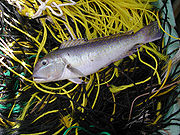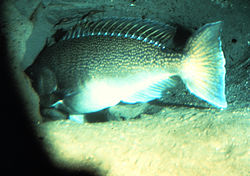|
Tilefish Fishing Miami
Tilefish
Tilefishes, also known as blanquillo, are mostly small perciform marine fish comprising the family Malacanthidae.
Commercial fisheries exist for the largest species, making them important food fish, although the American Food and Drug Administration warns pregnant or breastfeeding women against eating them due to mercury contamination. The smaller, exceptionally colourful species are enjoyed in the aquarium.
Due to their low fecundities, commercially important species are threatened by overfishing via long-line and bottom trawling methods.
Physical description
The two subfamilies appear to be morphologically different, with members of Branchiosteginae having deep bodies, large heads and large, somewhat subterminal mouths. In contrast, members of Malacanthinae are slender with elongate bodies, smaller heads and terminal mouths.
Tilefish range in size from 11 centimetres (yellow tilefish, Hoplolatilus luteus) to 125 centimetres (great northern tilefish, Lopholatilus chamaeleonticeps) and a weight of 30 kilograms.
Both subfamilies have long dorsal and anal fins, the latter having 1-2 spines. The gill covers (operculum) have one spine which may be sharp or blunt; some species also have a cutaneous ridge atop the head. The tail fin may range in shape from truncate to forked. Most species are fairly low-key in colour, commonly shades of yellow, brown and gray. Notable exceptions include three small, vibrant Hoplolatilus species: the purple sand tilefish (H. Purpureus), Starck's tilefish (H. Starcki) and the redback sand tilefish (H. Marcosi).
Tilefish larvae are notable for their generous complement of spines and serrations on the head and scales. This feature also explains the family name Malacanthidae, from the Greek words mala meaning "many" and akantha meaning "thorn".
Habitat and diet


Great northern tilefish, Lopholatilus chamaeleonticeps
Generally shallow-water fish, tilefish are usually found at depths of 50-200 metres found in both temperate and tropical waters of the Atlantic, Pacific and Indian Oceans.. All species seek shelter in self-made burrows, caves at the bases of reefs or piles of rock, often in canyons or at the edges of steep slopes. Either gravelly or sandy substrate may be preferred, depending on the species.
Most species are strictly marine; an exception is found in the blue blanquillo (Malacanthus latovittatus) which is known to enter the brackish waters of Papua New Guinea's Goldie River.
Tilefish feed primarily on small benthic invertebrates, especially crustaceans such as crab and shrimp. Mollusks, worms, sea urchins and small fish are also taken.
Behaviour and reproduction


Tilefish live in burrows, sometimes forming undersea Pueblo villages. Lopholatilus chamaeleonticeps
Active fish, tilefish keep to themselves and generally stay at or near the bottom. They rely heavily on their keen eyesight to catch their prey. If approached, the fish will quickly dive into their constructed retreats, often head-first. The chameleon sand tilefish (Hoplolatilus chlupatyi) relies on its remarkable ability to rapidly change colour (with a wide range) to evade predators.
Many species form monogamous pairs, while some are solitary in nature (e.g., ocean whitefish, Caulolatilus princeps), and others colonial. Some species, such as the rare pastel tilefish (Hoplolatilus fronticinctus) of the Indo-Pacific, actively builds large rubble mounds above which they school and in which they live. These mounds serve as both refuge and as a micro-ecosystem for other reef species.
The reproductive habits of tilefish are not well studied. Spawning occurs throughout the spring and summer; all species are presumed not to guard their broods. Eggs are small (<2 mm) and made buoyant by oil. The larvae are pelagic and drift until the fish have reached the juvenile stage.
Species


Great northern tilefish, Lopholatilus chamaeleonticeps
There are forty-two species in five genera.
The family is further divided into two subfamilies: Branchiosteginae or Latilinae and Malacanthinae. Some authors regard these subfamilies as two evolutionarily distinct families (in which case the former subfamily is recorded as Branchiostegidae).
South Florida and Miami fishing available at an affordable price. |











